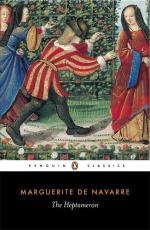the discredit of the monks (something, though less,
is said against the secular clergy), and especially
of the Cordeliers or Franciscans, an Order who, for
their coarse immorality and their brutal antipathy
to learning, were the special black (or rather grey)
beasts of the literary reformers of the time.
In a considerable number there are references to actual
personages of the time—references which
stand on a very different footing of identification
from the puerile guessings at the personality of the
interlocutors so often referred to. Sometimes
these references are avowed: “Un des muletiers
de la Reine de Navarre,” “Le Roi Francois
montre sa generosite,” “Un President de
Grenoble,” “Une femme d’Alencon,”
and so forth. At other times the reference is
somewhat more covert, but hardly to be doubted, as
in the remarkable story of a “great Prince”
(obviously Francis himself) who used on his journeyings
to and from an assignation of a very illegitimate character,
to turn into a church and piously pursue his devotions.
There are a few curious stories in which amatory matters
play only a subordinate part or none at all, though
it must be confessed that this last is a rare thing.
Some are mere anecdote plays on words (sometimes pretty
free, and then generally told by Nomer-fide), or quasi-historical,
such as that already noticed of the generosity of
Francis to a traitor, or deal with remarkable trials
and crimes, or merely miscellaneous matters, the best
of the last class being the capital “Bonne invention
pour chasser le lutin.”
In so large a number of stories with so great a variety
of subjects, it naturally cannot but be the case that
there is a considerable diversity of tone. But
that peculiarity at which we have glanced more than
once, the combination of voluptuous passion with passionate
regret and a mystical devotion, is seldom absent for
long together. The general note, indeed, of the
Heptameron is given by more than one passage
in Brantome—at greatest length by one which
Sainte-Beuve has rightly quoted, at the same time
and also rightly rebuking the sceptical Abbe’s
determination to see in it little more than a piece
of precieuse mannerliness (though, indeed,
the Precieuses were not yet). Yet even
Sainte-Beuve has scarcely pointed out quite strongly
enough how entirely this is the keynote of all Margaret’s
work, and especially of the Heptameron.
The story therefore may be worth telling again, though
it may be found in the “Cinquieme Discours”
of the Vies des Dames Galantes.
Brantome’s brother, not yet a captain in the
army, but a student travelling in Italy, had in sojourning
at Ferrara, when Renee of France was Duchess, fallen
in love with a certain Mademoiselle de la Roche.
For love of him she had returned to France, and, visiting
his own country of Gascony, had attached herself to
the Court of Margaret, where she had died. And
it happened that Bourdeilles, six months afterwards,




